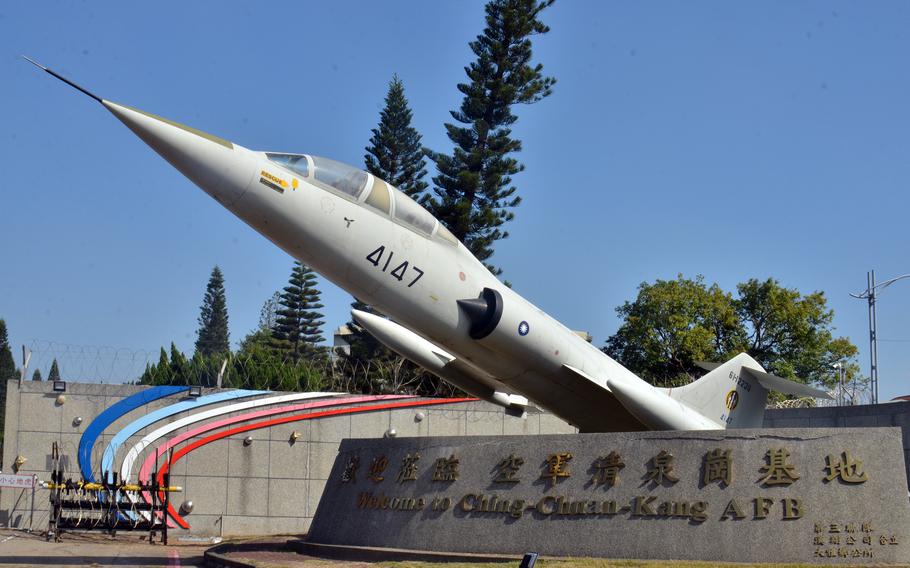
The entrance to Ching Chuan Kang Air Base in Taichung, Taiwan, is pictured on Jan. 13, 2023. (Seth Robson/Stars and Stripes)
CHING CHUAN KANG AIR BASE, Taiwan — This sprawling military installation in central Taiwan is likely the biggest reminder of an era when thousands of U.S. troops were deployed to the island.
CCK, as the air base in Taichung City was known to U.S. airmen who served there from 1957 to 1979, spans 1,750 acres and includes a 12,000-foot runway.
It was the second largest U.S. air base in the Far East after Clark Air Base in the Philippines, according to Tseng Mei-yao, director of a museum housed in a 1970s-era chapel on the base.
The chapel houses a large collection of items left behind by the Americans that includes everything from sports equipment to aircraft parts.
Significant numbers of American military personnel have not served there for decades. The U.S., however, plans to send between 100 and 200 troops to Taiwan, up from about 30 there a year ago, amid rising tensions with China, according to unnamed U.S. officials quoted Feb. 23 in the Wall Street Journal.
During the Vietnam War, CCK hosted the 374th Tactical Airlift Wing, which rotated its C-130E Hercules transports into Southeast Asia on combat missions. The wing, which shortened its name to the 374th Airlift Wing, is now stationed at Yokota Air Base in western Tokyo.
“This base was used extensively as a supply base during the Vietnam War,” Tseng said in a Jan. 13 interview at CCK. “It had 4,000 to 7,000 Americans at any one time.”
The 3rd Wing of the Taiwanese air force, based at CCK during the American era, is still there.
The unit traces its lineage to pilots who fought alongside U.S. forces against Japan in World War II. In the 1960s, the wing flew F-104G Starfighters, but these days it flies Taiwan-made Indigenous Defense Fighters, Tseng said.
Aircraft from the base shot down a pair of Chinese MIG-19 fighters on Jan. 13, 1967, according to an information panel at the on-base museum.
The base chapel is surrounded by ancient American Jeeps and fuel trucks.
Inside are a diorama of the base and a wall displaying the insignia of U.S. units that were stationed there. Relics left by the Americans such as uniforms, flight helmets, sports equipment and furniture are displayed in alcoves. Old photos show B-52 bombers and F-4 Phantom II fighters at the base.
One photo shows local bars of the American era with names such as the Tokyo Club, Ruby Club and Playboy Bar. Others show U.S. and Taiwanese troops partying together and a staff member at the noncommissioned officers club giving an airman tips on using chopsticks.
There’s a picture of comedian Bob Hope performing at CCK. An autographed photo of fighter ace Chuck Yeager, who visited the base, hangs nearby.
CCK is designed with durable infrastructure and separate work and living areas, said Maj. Wei Chia-hsing, 31, who flies with the 3rd Wing’s 28th Fighter Squadron.
The chapel and the base golf course are the main physical reminders of the American presence, the eight-year air force veteran told Stars and Stripes on Jan. 13.
However, traditions such as clubs for enlisted airmen and officers and Christmas parties have continued, he said.
U.S. troop strength on Taiwan peaked at 19,000 in 1958 and dropped to between 4,000 and 10,000 by the 1970s, according to the conservative Heritage Foundation.
The U.S. military presence at CCK and on Taiwan was ended by President Jimmy Carter, who withdrew from the Sino-American Mutual Defense Treaty in 1979. Congress responded by passing the Taiwan Relations Act, which requires the U.S. to sell arms to Taiwan for its defense.